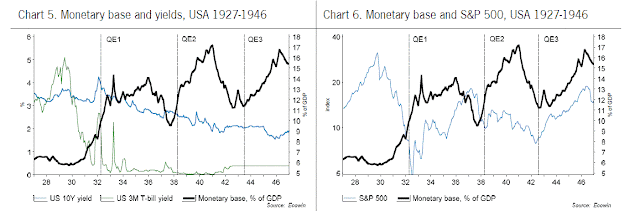However, equities failed to appreciate during second expansion of monetary base, while 10 year Treasury yields continued to move down in 1930ties. Take a look at charts below, prepared by SEB's x-asset team, click to enlarge.
For inquiring minds the question of "WHY?" should arise. Well, the same Paul Krugman provided the explanation using accounting identities?:
The process of paying down debt, however, must obey two rules:
1. Those who pay down debt must do so by spending less than their income.
2. For the world as a whole, spending equals income.
It follows that
3. Those who are not being forced to pay down debt must spend more than their income.
But here’s the problem: there’s no good mechanism in place to induce those who can spend more to do so. Low interest rates do encourage spending; but given the size of the debt shock, even zero rates are nowhere near low enough.
So since the world economy can’t raise the bridge, it is lowering the water: without sufficient spending from those who can, the only way to make the accounting identities hold is for incomes to decline — specifically, the incomes of those not constrained by debt must decline so as to create a sufficiently large gap between their (unchanged) spending and their incomes to offset the forced saving of debtors. Of course, the mechanism here is an overall global slump, so the debtors are squeezed as well, forced into even more painful cuts.

No comments:
Post a Comment